|
ARBOR Technology Gladius 10
Rugged, affordable multi-purpose octa-core powered 10-inch Android tablet for numerous enterprise and field applications in logistics, mapping, data collection and more
By Conrad H. Blickenstorfer; photography by Carol Cotton
ARBOR Technology, a Taiwan-based ISO-9001 certified embedded and networking manufacturer founded in 1993, announced the Gladius 10 in 2015 as a general-purpose 10-inch class rugged Android tablet for a variety of enterprise and field applications. RuggedPCReview has had a chance for extended hands-on with the Gladius 10, and this report presents our review and observations.
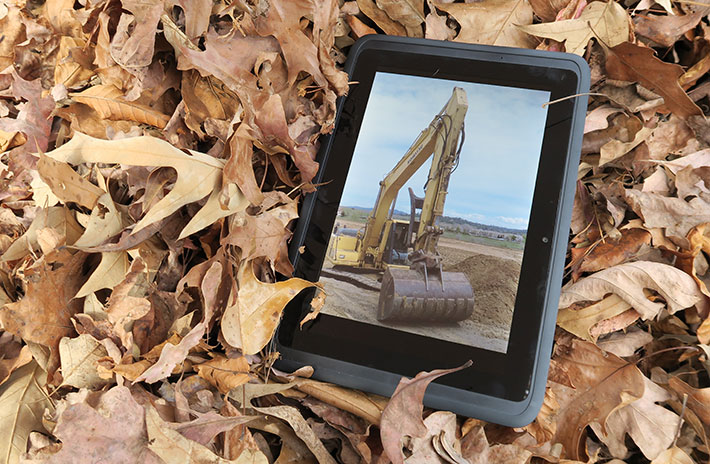
The growing lineup of ARBOR's rugged Gladius tablets
ARBOR has been on a tear as of late. Over the past 18 months or so, the company has introduced a number of rugged handhelds and tablets, all designed to meet enterprise and industrial customers' demand for contemporary mobile technology that's more versatile and far more durable than consumer devices. To provide an idea of where ARBOR's new products fit into the overall mobile computing landscape in terms of size, the image compilation below shows how recent Gladius models compare with each other, and with Apple's iPhone 6 and iPad.

The lineup shows — from left to right and in scale — Apple's iPhone 6s Plus, the ARBOR Gladius 5 (see our review), the ARBOR Gladius 8 (see our review), the Apple iPad Air 2, and finally the ARBOR Gladius 10, which is the subject of this report.
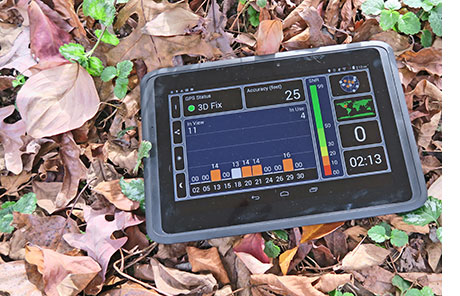 The Gladius 10 measures 11 x 7.5 inches, versus the iPad Air 2's 9.4 x 6.7. Its 10.1 inch diagonal screen size is a bit larger that of the iPad (9.7 inches), and between the extra ruggedness padding and the wider 16:10 display aspect ratio display it does look quite a bit more substantial than the standard iPad. The Gladius 10 measures 11 x 7.5 inches, versus the iPad Air 2's 9.4 x 6.7. Its 10.1 inch diagonal screen size is a bit larger that of the iPad (9.7 inches), and between the extra ruggedness padding and the wider 16:10 display aspect ratio display it does look quite a bit more substantial than the standard iPad.
There's more to a tablet, though, than just the size of the display. As a ruggedized device, the Gladius 10 is 0.9 inches thick, and weighs 2.3 pounds. That's significantly thicker and heavier than today's consumer tablets. The iPad Air 2 is sliver-thin at less than a quarter of an inch and weighs less than a pound. We just mention that to establish right upfront that the Gladius 10 is a serious tool for tough jobs, and not only a generic tablet with a bit of extra protection.
Also note that while (some) consumer smartphones are starting to be better sealed and protected against the elements and abuse, the same hasn't happened yet with consumer tablets. If reliable Android tablet functionality is needed in the field, we're looking at something tough and rugged and designed specifically for the field, something like the Gladius 10.
Gladius 10 technology
Unlike virtually all Windows systems that use one kind of Intel chip or another (with still a few AMD-based designs here and there), Android devices use a very wide range of mostly ARM-based chips from a variety of chip foundries. For the Android members of its Gladius line of products, ARBOR has been going with Taiwanese semiconductor company MediaTek.
 Just like the smaller Gladius 5 and Gladius 8, the Gladius 10 uses an ARM Cortex A7 processor from MediaTek. However, whereas the Gladius 5 uses the 1.0GHz MTK6589 designed for smartphones, and the Gladius 8 the more tablet-oriented 1.3GHz MTK8382 — both quad-core designs built on contemporary 28nm process technology — the Gladius 10 ups the ante with an octa-core processor running at 1.7GHz, the MediaTek MT8392. Just like the smaller Gladius 5 and Gladius 8, the Gladius 10 uses an ARM Cortex A7 processor from MediaTek. However, whereas the Gladius 5 uses the 1.0GHz MTK6589 designed for smartphones, and the Gladius 8 the more tablet-oriented 1.3GHz MTK8382 — both quad-core designs built on contemporary 28nm process technology — the Gladius 10 ups the ante with an octa-core processor running at 1.7GHz, the MediaTek MT8392.
What exactly does the octa-core processor bring in terms of performance, and how does it compare to other products? For now, that's hard to say, as we have far fewer Android than Windows benchmarks. In addition, Android's processor and OS version fragmentation makes benchmark results less directly comparable than those in the Wintel x86 world. That said, the octa-core Gladius 10 scored roughly twice as high in the AnTuTu v5.7.1 benchmark than the quad-core Gladius 8, a result roughly confirmed in BaseMark OS II and the Vellamo Metal, Multicore and Browser scores.
On the memory front, there's 2GB of RAM and 16GB of Flash for storage. 16GB doesn't sound like much compared to current iPads that come with up to 128GB, but it's quite adequate if the device can use expansion cards (which the iPad can't). The Gladius 10 does have a user-accessible micro SDHC card slot inside its battery compartment.
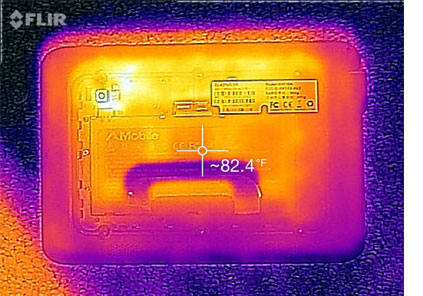 There is an 13mp documentation autofocus camera with LED flash on the backside, as well as a 5mp vidcam in the front. Unlike with the Gladius 8, the front camera is standard and not mutually exclusive with the scanner. There is an 13mp documentation autofocus camera with LED flash on the backside, as well as a 5mp vidcam in the front. Unlike with the Gladius 8, the front camera is standard and not mutually exclusive with the scanner.
As for the documentation camera's impressive imager size, the megapixel count is being pushed by some consumer smartphone and tablet manufacturers to differentiate themselves, and we certainly welcome that trend. Apple, though, stayed with 8mp in its iPad Air 2 and just 5mp in the iPad mini 3, so ARBOR is ahead of the game compared to most.
The Gladius 10 has a user-accessible 35.3 watt-hour Li-Ion battery. That's more battery capacity than the iPad Air 2's 27,6 watt-hours, and ARBOR's estimate of "up to 8 hours" of battery life between charges should be on the mark. Charging is via a standard micro-USB port, something we're not totally thrilled with due to the fragile nature of the tiny micro-USB standard connectors.
While Apple is using traditional 4:3 aspect ratio displays in all of its iPads, ARBOR's Gladius 5 uses the 16:9 ratio, the Gladius 8 the 4:3 ratio, and the Gladius 10 a 16:10 ratio. We're not sure of the reason for that. For the most part, aspect ratio seems a matter of personal viewing preference rather than functional advantage. Like virtually all Android devices, the Gladius 10 uses projected capacitive ("procap") multi-touch technology. While some vertical market rugged tablets still use resistive digitizers, procap is clearly the popular choice these days, and it is also what Android was designed for.
All modern tablets have a multitude of sensors, and the Gladius 10 is no different. There's a proximity sensor, a 3-axis accelerometer, a 3-axis magnetic field, a barometer, and an ambient light sensor to adjust backlight intensity. A system info utility we installed also claimed the presence of sensors handling orientation, gravity, temperature and rotation.
Wired connectivity is via micro-USB 2.0. For wireless connectivity there is integrated Class 2 Bluetooth 4.0LE + EDR, 802.11b/g/n WiFi, NFC, both A-GPS and dedicated GPS, and mobile broadband.
Look and feel
The image below shows the Gladius 10 from the front and from all four sides. It's a rather elegant design that combines the all-black glossy look of a modern consumer tablet with the protective rubber-cladding, meticulous sealing, and space for industrial grade expansion like a vertical market device.
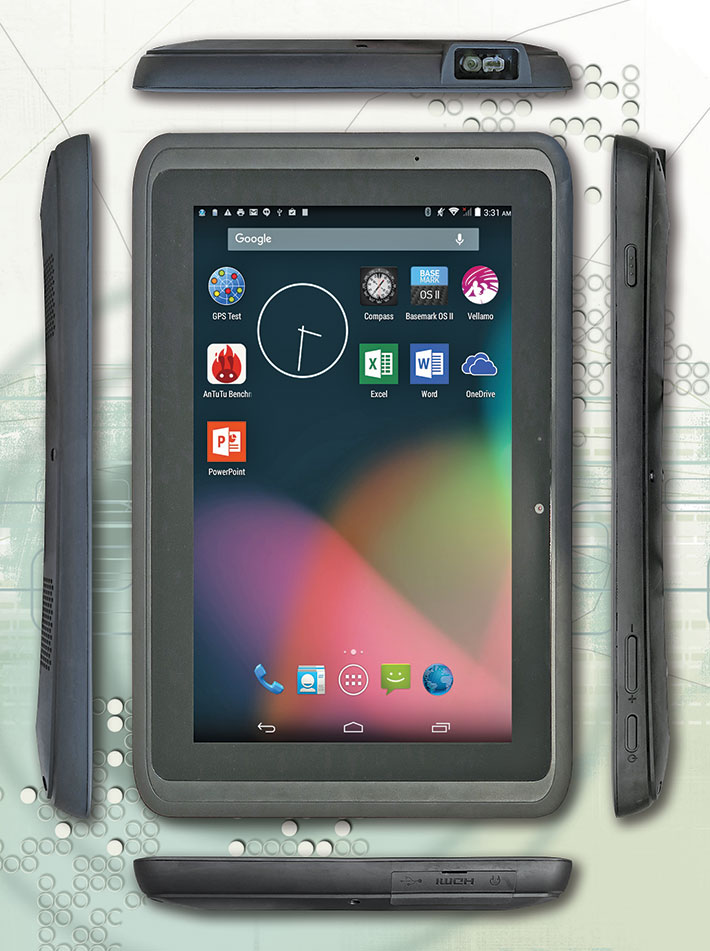
Going around the Gladius 10 reveals the necessary minimum of controls and ports. This is a well-sealed device, and that means the fewer openings that must be protected against immersion the better.
On the right side are a scanner button, a volume up/down rocker and the power button. On top is the scanner window. On the bottom the micro-USB port, a mini-HDMI port, and a 3.5mm headphone jack. That's it.
The front of the Gladius 10 is dominated by the large display whose surface glass extends well beyond the perimeter of the LCD, a characteristic common to virtually all capacitive touch devices, so that fingers do not bump into a border during touch. The sturdy polymer housing of the Gladius 10 does make for a slightly raised border around the perimeter of the tablet, but it's far enough away from the extent of the LCD to not get in the way, and it only sticks up by roughly a millimeter.
Note that the three standard Android controls (Back, Home, MultiTask) are implemented entirely onscreen. That has its pros and cons. On the plus side, they will always be in the proper place no matter the orientation of the display. On the minus side, they eat up some screen space and you can't always see them.
Design and construction of the Gladius 10
The more rugged tablets we review and analyze here at RuggedPCReview.com, the more we empathize with tablet designers. How many ways are there to create a product that consists of a rectangular housing with a rectangular piece of glass? How can vendors differentiate themselves from the competition? And how much time must be spent to miniaturize everything so the tablet will be thin enough to please today's customers?

Fortunately, creators of enterprise and rugged tablets have a bit more design leeway because corporate customers understand the importance of substance over style. Yes, even rugged tablets must conform to the current "sleek and slender" mantra of tablet design, but there's still room for innovative solutions as long as they enhance functionality of the product. ARBOR's Gladius tablets are great example of that. At first sight the Gladius 5, 8 and 10 look very much alike except for size. A closer look quickly reveals that each was designed very specifically for its size, purpose, and mission.
So let's examine the Gladius 10 in detail. The picture to the right shows the backside of the tablet. It's black plastic, beveled, and almost completely unadorned. There are the two small lenses for the rear camera and its flash. There are the grilles for the two speakers. And there's a boxy accommodation for the unit's barcode scanner. Nothing else.
The removable plastic plate that provides access to the battery and card slots is secured with six large screws that can be opened with a flat screw driver, a coin, or even a fingernail. The design is such that the screws won't fall out, which is much appreciated. Carefully unsnap the cover to see the flat (only 8mm thick) 3.8 Volt 9,300mAH 35 watt-hour battery that neatly fits into a compartment of the metal frame.
Also accessible now are the dual SIM card slots, and the micro SD card slot. The rear camera and its LED flash are bare now, too, so make sure not to damage them or get them dirty. This bay is open to the actual inside of the Gladius 10, so all sealing is done via a replaceable rubber O-ring around the entire compartment. It has little tabs on it so it is easier to place properly. The O-ring easily comes loose. We'd have liked for it to stick inside its groove to lessen the likelihood of damage. And do note that having the micro SD card slot inside the well-secured battery compartment means you can't quickly pop in or remove a card.
To separate the two halves the Gladius 10 consists of, there are eight Philips screws around the perimeter and 14 inside the battery compartment to be undone. The eight outer ones sits recessed inside the back cover and underneath little black rubber plugs. Once all screws are out, a plastic separater tool should be used to gently pry the two halves apart. The emphasis is on gently. You don't want to crush or break the snap-on retainer loops.
Sealing between the two halves is done with an elaborate tongue-and-groove design and a very slender rubber o-ring, making it two o-rings to keep an eye on.
The pictures below shows what it looks like inside the Gladius 10, with just the battery compartment cover off on the left, and the entire tablet open on the right:
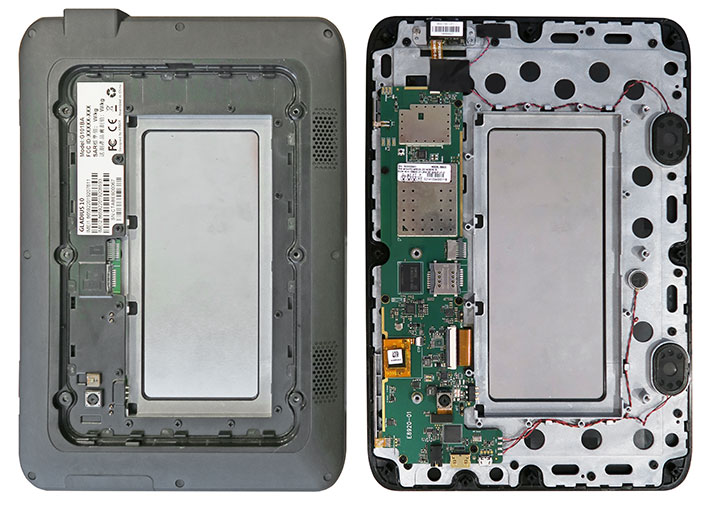
The top half of the tablet consists of the unit's exceptionally sturdy magnesium frame that has the LCD assembly mounted on one side, and the tablet's electronics on the other. Compared to virtually all x86 Windows tablet designs, the Gladius is amazingly sparse and clean inside. The slender system board measures 8-1/2 x 2 inches and looks as neat and simple as something from Apple. No busy layout here, and no complex stacked daughterboards and modules.
Reassembly requires some care. Just like plastic snaps often don't like to let go, they may need some special prodding to snap back in place. Here again it's a matter of finesse and patience rather than applying force.
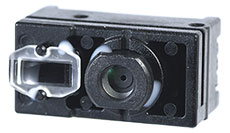 The barcode scan engine in our evaluation unit was an Opticon MDC-100 (see here) using CCD linear sensor technology and a red LED as a light source. It's a tiny module that supports a wide variety of 1D barcodes and postal codes. Note that the ARBOR Gladius 8 we evaluated a few months ago used the Opticon MDI-3100, a fixed-focus LED_based 2D CMOS imager, which likely is available for the Gladius 10 as well. The barcode scan engine in our evaluation unit was an Opticon MDC-100 (see here) using CCD linear sensor technology and a red LED as a light source. It's a tiny module that supports a wide variety of 1D barcodes and postal codes. Note that the ARBOR Gladius 8 we evaluated a few months ago used the Opticon MDI-3100, a fixed-focus LED_based 2D CMOS imager, which likely is available for the Gladius 10 as well.
Below you can see close-ups of some of the interesting details of the ARBOR Gladius 10. On the left is one of the nicely sized speakers mounted inside its own protective metal seat. It'll never come loose by accident. In the center is another look at the tablet's industrial-grade Opticon barcode reader. On the right are the SIM and micro SD card slots.

Below on the left is a look at the I/O section of the motherboard with the micro USB port, the micro HDMI port, and the power jack. On the right is a detail shot of the rubber O-ring sitting in its groove that goes around the entire perimeter of the Gladius 10.

The interior of the Gladius 10 leave a good impression. It is a well conceived and executed design that's very structurally stable. The sole concerns we have are the long o-rings that can easily get damaged, and the snap-together design of the housing and the battery compartment cover.
Display — 10.1-inch and procap multi-touch
The Gladius 10's 10.1-inch display is in what used to be the "full-size" tablet class, i.e. the standard that Apple set with the original iPad. But display sizes are forever changing, and the latest move now is towards larger screen sizes, such as the Microsoft Surface 4 and Apple iPad Pro, both in the 12-13 inch class. In our opinion, 10.1 inches is plenty for Android, which so far has seen less of a differentiation between phone and tablet optimized apps.
The screen's 1,280 x 800 pixel WXGA resolution is not tremendous in an era where much smaller smartphones routinely offer 1920 x 1080 pixel displays, and some even full 4k. As is, WXGA offers barely more pixels than ARBOR's own Gladius 5 has on its much smaller 5.5 inch screen (1280 x 720). So why did ARBOR use comparatively low 1,280 x 800 resolution in the Gladius 10?
To put things in perspective, 1,280 x 800 is is actually sharper than the original iPad and the iPad 2 were, and no one complained about their resolution. 1,280 x 800 resolution on a 10.1-inch display means 149 dpi (dots per inch) here, which is the same as that of the original Samsung Galaxy Tab 10.1, a very successful tablet. It's also better than any non-retina MacBook Pro and Air laptops. And it's much sharper than the display of the Apple iMac27 this review was written on.
We dwell on this because mobile display technology is quickly moving to a point where users expect "retina" displays, i.e. individual pixels so small as to be no longer discernible with the naked eye. DPI, of course is not all that counts. Wide viewing angles and the lack of color shifts are often as important or more. And here the Gladius 10 shines with a perfect viewing angle from all directions, with no color shifts whatsoever.

Capacitive multi-touch works as smoothly and effortlessly as expected from a tablet these days. But while the touch controller of the smaller Gladius 8 worked even with thin gloves, the Gladius 10 requires finger touch. The tablet doesn't come with a stylus and ARBOR doesn't offer an optional capacitive pen. Any 3rd party capacitive pen will work, though those generic pens with their broad tips don't offer much more accuracy than the tip of a finger. It's not that important anyway as Android was specifically developed for capacitive multi-touch with a finger.
Android versus Windows
The review Gladius 10 ARBOR sent us ran Android 4.4 "KitKat." But ARBOR also offers the very similarly sized Gladius G0975 that runs Microsoft Windows. With that, ARBOR follows the industry-wide trend of offering both of these major operating system platforms on similar and sometimes identical hardware. Why?
There is no universal answer, and the reasons are different for tablets than they are for smaller handheld devices. Rugged industrial handhelds predate Android, and most of them ran Microsoft's Windows CE or Windows Mobile (now called Windows Embedded Handheld, or WEHH). When Microsoft neglected to provide a clear upgrade path for handhelds a few years ago, manufacturers continued to stay with the by now ancient WEHH 6.5. However, since Android totally dominates the Smartphone market, most vendors are now also offering Android-based rugged handhelds, hedging their bets.
On the tablet side, things are a bit different. While Apple and Android also hold a commanding marketshare, for one reason or another many rugged and vertical market tablets are Windows-based. It may be that enterprise Microsoft shops wish to leverage their Windows investment to tablets rather than supporting another software platform, or it may be that complex industry-specific software is only available on Windows. Almost all providers of rugged tablet hardware have realized that, and are offering both Windows and Android tablets.
As is, given Android's massive overall deployment, Android-based work devices have instant appeal and familiarity to those who are already using Android smartphones and/or tablets at home or at work, which is almost everyone. Though often customized by voice and data service providers, the basics of using Android are widely known by now, often eliminating learning curves. Android software development and expertise is also commonly available. All of that means that making Android devices available on the job can save training as well as deployment costs.
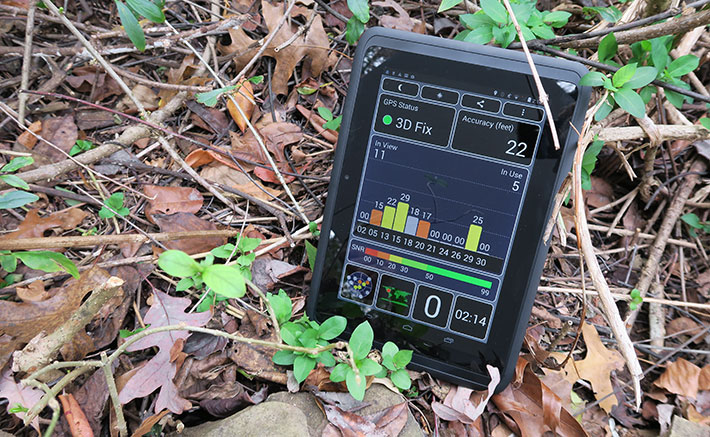
Additional Android contemplations
The overall number of available apps for competing software platforms has gone beyond bragging rights to become a crucial marketing issue. How many apps are available? Are all of the important portals and social media sites supported? How easy is it to download apps? Apple, of course, has its massive and very user-friendly App Store. Android boasts the rapidly improving official 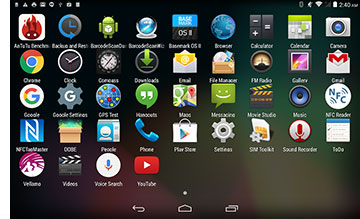 Google Play store, and there is a number of third party alternatives such as the Amazon Appstore for Android, Slide ME, and several others. Google Play store, and there is a number of third party alternatives such as the Amazon Appstore for Android, Slide ME, and several others.
Frustratingly absent from the current app stores is a differentiation between consumer and industrial markets. It's often hard to tell if an app is a hobbyist's science project or an industrial-grade piece of software. And whereas a large number of easily accessible apps is great for consumers, industrial and corporate deployers may not want their workforce download apps into devices used for work. How can this issue be handled?
One approach is for manufacturers of professional Android devices to use Android AOSP. It's an open source software project, led by Google itself, that does not include access to the Google Play store and some of the major Google apps.
There are also third party utilities and platforms that address such issues. 42Gears.com's SureLock, for example, replaces the Android desktop and allows control of applications that are available to users. It can even run in a "kiosk mode" with just a single application that is always active. This way, systems integrators or IT personnel can configure units for specific use and applications, eliminating the temptation that comes with a full load of consumer apps.
The Gladius 10 sample unit ARBOR sent us for evaluation came not only with a basic selection of useful apps, but also with the official Google Play store. Google does make it possible to customize the look and feel of an Android device, and organizations can publish their own Android apps or officially sanctioned apps privately to a dedicated company-owned channel on Google Play.
Applications galore
One of the benefits of massive marketshare is a large and constantly growing wealth of applications readily available for download. That's certainly one of the main attractions of Android tablets. Specialized and more complex applications may require custom software development, but chances are that an inexpensive (or even free) app can be found for almost everything else. In the past we often highlighted some interesting apps to illustrate how a tested mobile device could be used, but by now pretty much everyone is aware of that. So we'll just point out a couple of obvious benefits of using a competent Android tablet such as the Gladius 10.
For example, while there are several office suites available for Android, most enterprise and business users will want Microsoft Office. An Office 365 client is available for Android. It is not a complete implementation of the full Office 365, but it is far more comprehensive than the "mobile" versions of Word, Excel and PowerPoint Microsoft used to offer. Below are screen shots of the three major Office apps.
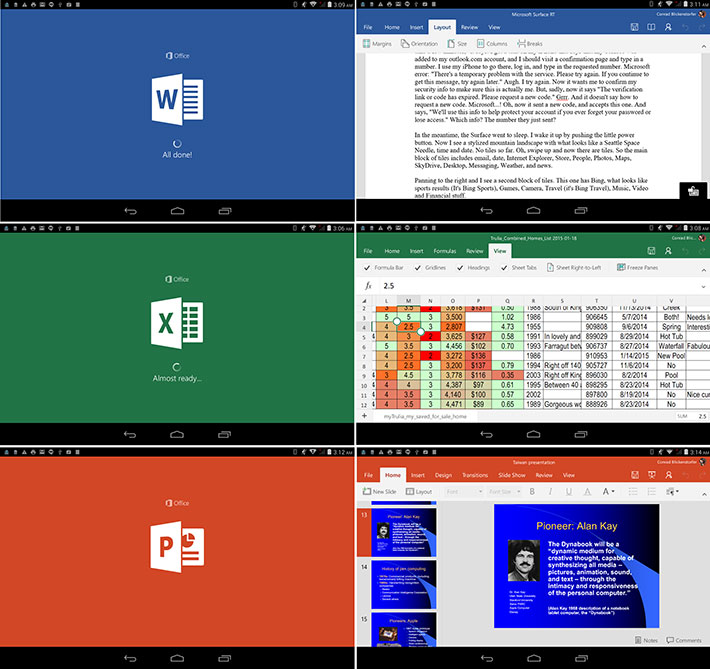
Another area where tablets shine is GPS and mapping. Mapping software on desktops is one thing, but being able to have it all on a tablet in the field is another. And the display of the Gladius 10 is large and sharp enough to serve as a great tool for many mapping jobs.
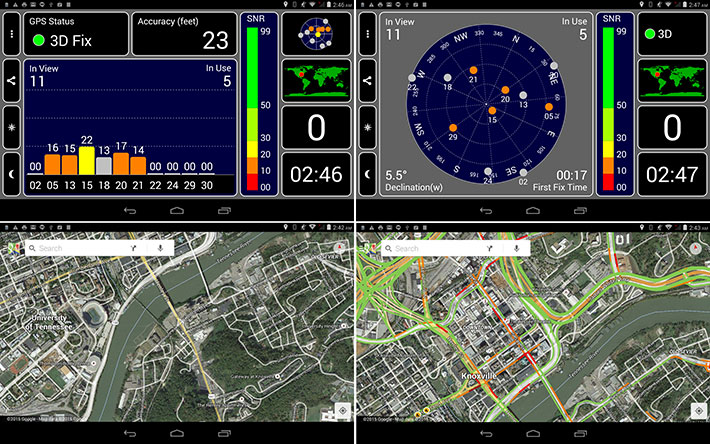
The above illustrates just a couple of areas where a modern rugged tablet such as the Gladius 10 tablet can be used for. Many thousands of other apps are available, on top of whatever custom or professional software users may wish to install.
Excellent cameras
As customers expect these days, the ARBOR Gladius 10 has both a front and a rear camera. The front one is for video calls and such, and offers 5 megapixel resolution. The rear one is for picture taking and documentation. That one has a 13 megapixel imager, which was confirmed by the 4,864 x 2,736 pixel resolution pictures we took. Camera settings allow selecting resolutions from just QVGA all the way up to 13mp. Both cameras can be used for stills as well as for video.
Over the years, our experience with cameras integrated into rugged vertical market handhelds and tablets has been quite disappointing, with even the best ones usually lagging way behind what's available in dedicated point & shoots and consumer smartphones. 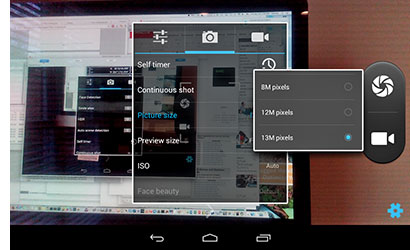 Only recently have we seen improvement in integrated cameras, possibly through the very wide distribution of Android-based smartphones equipped with good cameras.
Only recently have we seen improvement in integrated cameras, possibly through the very wide distribution of Android-based smartphones equipped with good cameras.
We are pleased to report that the rear-facing documentation camera of the Gladius 10 is actually very good. The test pictures we took with the device were plenty good enough for virtually every documentation task.
The screen snap to the right shows some of the camera settings screens, and what it looks like in picture-taking mode.
The user interface is quite elaborate, with 14 scene settings, 7 color effects, 8 white balance settings, +/-3EV exposure control, face detection, 2/10 second self timer, 40 or 99 continuous shots, picture sizes from VGA all the way up to 8mp, ISO settings from 100 to 1600 and auto, HDR capturing, panorama shooting, and more. When using the front camera, the focus can follow your face automatically, which comes in handy if you move around a lot.
Users can edit pictures right on the Gladius 10. There is a wealth of functions available, including color effects, frames, cropping, straightening, mirroring, numerous filters, and even such advanced operations as sharpening, hue, vibrance and curves. The camera app also supports social media. You can directly send images to Picasa, Messaging, email, Skype, OneDrive or whatever other social media apps you have on the device. And images can also be converted to PDF.
In video mode, there is a special meeting recording setting for audio recording, and the microphone can be turned on and off. There is also time lapse video with a picture taken shot every one to 10 seconds, and users can set video quality. We got video to record in resolutions ranging from 640 x 480 VGA all the way up to full 1080p 1920 x 1080. Video quality was quite good, frame rates as well, and the LED illuminator was strong enough to be of real life use.
Having all those many settings and features available will be important to some users, but what's most impressive about the Gladius camera apart is its speed and quality. It is well suitable to document jobs both in stills and in video.
The pictures below were shot with the ARBOR Gladius 10 in 13mp mode. Click on the image to bring up a full-size version.
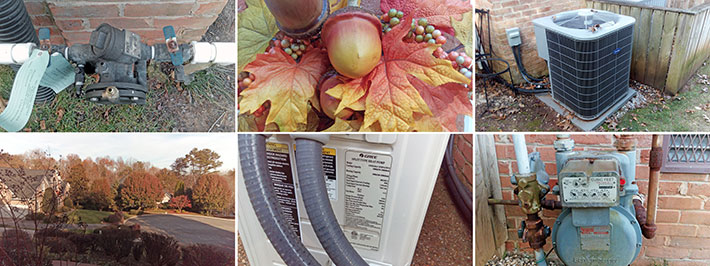
The Gladius 10 documentation camera is capable of taking MUCH better pictures than we generally see from industrial tablets. There is very good sharpness and image detail, and none of the excessive compression that often makes images from taken with such integrated cameras useless.
Video is also much better than what we've come to expect from cameras integrated into rugged devices. Frame rate and focussing are quick and the camera doesn't fall behind. The maximum 1920 x 1080 recording format is very useful, and, of course, pretty much expected by today's users.
In summary, the still image and video functions of the Gladius 10 are far better than average and good enough for virtually any documentation jobs.
Much tougher than any consumer tablet
There was a time when rugged tablets were thick and heavy. That didn't matter much because those tablets were still quite a bit lighter than rugged laptops of that era. Things have changed, and even rugged tablets must be as thin and light as possible to have a chance to be considered over inexpensive consumer tablets in a protective case. Has that development hurt ruggedness? Not as far as the Gladius 10 goes. It sports impressive environmental protection specs, and one look at its internal design shows that the sleek and elegant Gladius can back it up. This tablet is much tougher than it looks.
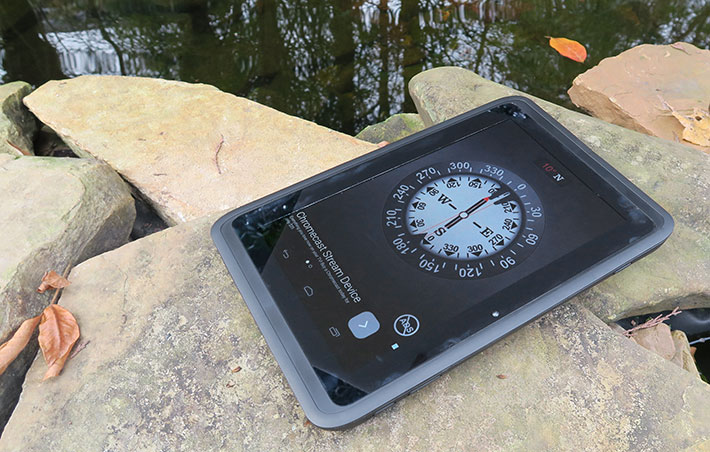
For protection against the elements, the Gladius 10 carries IP65 sealing where the "6" means it's totally dustproof, and the "5" that it is also sealed against, according to the IP classification system chart, low pressure water jets from all directions. That's far better sealing that standard consumer tablets have (many have no sealing rating at all). Note, however, that many consumer smartphones are now available in IP67- and even IP68-sealed versions, and this raises expectations. It's not as easy to effectively seal larger devices than smaller ones, but the day can't be far when IP67 is considered mandatory. It's not crucial, but it's good to know that an expensive electronic tool could survive an accidental drop into a puddle.
People carry tablets around, which means they can (and most likely will) at some point drop from approximately four feet. That's height a tablet is held while being operated in a standing position. The Gladius 10 can also handle such drops. That's where the tough polymer housing comes in handy, and the extra thickness and the sturdy metal frame inside.
The stated operating temperature range of 14 to 122 degrees Fahrenheit (-10 to 50 degrees Celsius) is wide enough to allow the device to be used almost anywhere. We'd actually like to see a somewhat wider range. It can easily get hotter than 120F in many parts of the world, and colder than 14F as well.
The image below shows the Gladius 10 standing near a small waterfall with water splattering over it and the tablet being partially submerged. There were no problems at all.
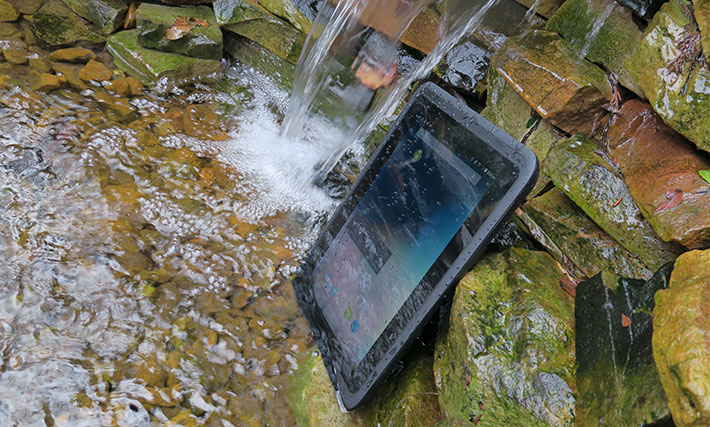
The display uses Corning Gorilla Glass 3 that provides even more protection against breakage and scratching than the first two generations. That's especially important in large-screen handhelds such as the Gladius 10.
ARBOR's literature mentions MIL-STD-810G certification, but does not say which MIL-STD-810G or similar tests, specifically, have been performed. Vibration, for example, can be a big issue if a device rattles around in a vehicle or if it's mounted on something that vibrates a lot. Users may also want to know its ability to handle tumbles, altitude, shock, and other punishment that may well be an issue in some of the more demanding applications.
Judging by its look and feel, as well as by what we found inside the unit, believe that that the ARBOR Gladius 10 should hold up well in the field and under tough operating conditions. Its design and structural integrity are first rate, the sealing well implemented, and Gorilla Glass has proven to be very effective for display protection. However, we'd like to see more actual ruggedness test results in the specs.
Summary: ARBOR Gladius 10 — versatile, rugged 10-inch class Android tablet for numerous enterprise and field applications
With the Gladius 10, ARBOR Technologies presents a tough, rugged and quite affordable 10-inch Android tablet suitable for any number of corporate and field deployments. It's far more durable than any consumer tablet, yet at 2.3 pounds still light enough to go anywhere.
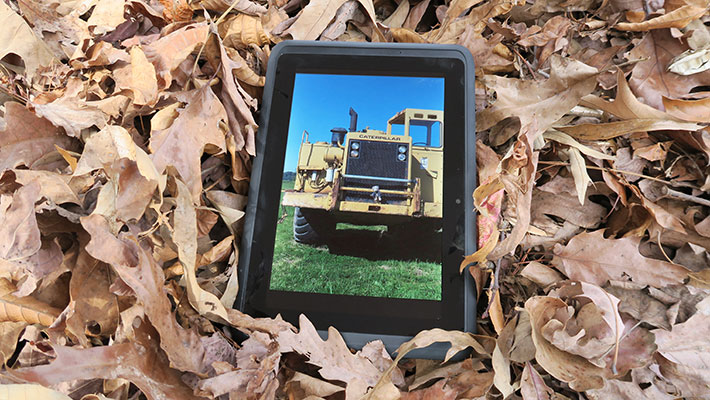
The bright 10.1-inch capacitive multi-touch display offer enough screen real estate for serious work, making it suitable for applications where handhelds and small tablets just won't do. The 1280 x 800 WXGA resolution is sufficiently sharp even for mapping and other GIS work.
A powerful 1.7GHz octa-core processor provides very good performance. There's no potentially troublesome fan, and the tablet runs silently without noticeable heat buildup.
The replaceable battery lasts a full shift and more. There's an industrial-grade 1D/2D CMOS imager for quick and reliable data capture, and an excellent 13-megapixel documentation camera. The Gladius 10 can survive 4-foot drops, operate in a wide enough operating temperature range to be used almost anywhere, and its IP65 sealing means it is immune to dust or rain.
With the Android-powered Gladius 10, ARBOR offers a rational, elegant multi-purpose tablet for numerous field, mapping, transportation, healthcare, mPOS and general industrial and enterprise deployments. And it comes at a very reasonable price.
-- Conrad H. Blickenstorfer, December 2015
ARBOR Technology Gladius 10 Specs:
| Added/changed |
Added 12/2015, full review 12/2015
|
| Type |
Rugged Android tablet
|
| Processor |
1.70GHz Octa-core Cortex A7 MediaTek MTK MT8392
|
| Graphics |
ARM Mali-450 GPU
|
| OS |
Android 4.4 (KitKat)
|
| Standard/Max RAM |
2GB/2GB |
| Disk/drive |
16GB onboard, plus microSD card storage |
| Display type |
TFT LCD with anti-reflective coating and Gorilla glass 3 protection |
| Display size/resolution |
10.1-inch/WXGA (1,280 x 800 pixel) with anti-reflective properties |
| Digitizer |
5-point projected capacitive multi-touch |
| Keyboard/keys |
Onscreen
|
| Navigation |
Touch
|
| Expansion slots |
1 x microSD/SDHC Card (up to 32GB), 2 x SIM card
|
| Housing |
Polymer over magnesium frame
|
| Size |
11.0 x 7.5 x 0.9 inches (278 x 191 x 23 mm)
|
| Weight |
2.3 lb. (1,035 grams) with battery
|
| Operating temperature |
14° to 122°F (-10° to 50°C) |
| Ingress protection |
IP65 (totally dustproof, sealed against low pressure water jets from all directions) |
| Humidity |
95% non-condensing |
| Drop |
4-foot drops |
| Vibration |
MIL-STD-810G testing |
| Altitude |
Unknown |
| Tumble |
Unknown |
| ESD |
Unknown |
| Power |
Field-replaceable 3.8V, 9,300mAh 35.34 watt-hour ("up to 8 hours") |
| Regulatory |
est: FCC, CE, CB, UL, NCC. A-TICK/C-TICK, VCCI, Japan TELEC |
| Camera |
Front: 5.0 megapixel, rear: 13 megapixel auto-focus with LED flash |
| Scanner |
Est: Optional dedicated Honeywell N4313 1D laser scanner or Honeywell N5600 1D/2D imager |
| Sensors |
Ambient light, 3-axis gyroscope, accelerometer, barometer, e-compass, proximity, orientation, magnetometer, pressure, temperature, gravity |
| Communication |
802.11b/g/n, Class 2 Bluetooth 4.0 LE + EDR, 13.56MHz RFID/NFC, GPRS/EDGE, 3G HSPA+, GPS, A-GPS |
| Interface |
1 x micro USB 2.0, 1 x mini-HDMI, 1 x 3.5mm headphone |
| Price |
Inquire |
| Spec sheet |
 Gladius 10 brochure (PDF) Gladius 10 brochure (PDF)
|
| Web page |
Gladius 10 web page |
| Contact |
ARBOR Technology Corp.
10F., No.700, Zhongzheng Rd.
Zhonghe Dist., New Taipei City 235
Taiwan, R.O.C.
Tel: 886 2 8226 9396
Fax: 886 2 8226 9398
Web: http://www.arbor-technology.com
|
|



